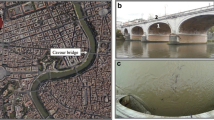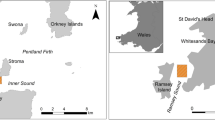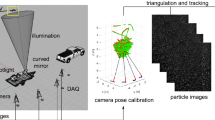Abstract
Advances in flow monitoring are crucial to increase our knowledge on basin hydrology and to understand the interactions between flow dynamics and infrastructures. In this context, image processing offers great potential for hydraulic monitoring, allowing acquisition of a wide range of measurements with high spatial resolution at relatively low costs. In particular, the particle tracking velocimetry (PTV) algorithm can be used to describe the dynamics of surface flow velocity in both space and time using fixed cameras or unmanned aerial systems (UASs). In this study, analyses allowed exploration of the optimal particle seeding density and frame rate in different configurations. Numerical results provided useful indications for two field experiments that have been carried out with a low-cost quadrocopter equipped with an optical camera to record RGB videos of floating tracers manually distributed over the water surface. Field measurements have been carried out using different natural tracers under diverse hydraulic and morphological conditions; PTV’s processed velocities have been subsequently benchmarked with current meter measurements. The numerical results allowed rapid identification of the experimental configuration (e.g., required particle seeding density, image resolution, particle size, and frame frequency) producing flow velocity fields with high resolution in time and space with good agreement with the benchmark velocity values measured with conventional instruments.









Similar content being viewed by others
References
Adrian, R. J. (2005). Twenty years of particle image velocimetry. Experiments in Fluids, 39(2), 159–169.
Adrian, R. J., & Westerweel, J. (2011). Particle image velocimetry. New York: Cambridge University Press.
Brevis, W., Niño, Y., & Jirka, G. H. (2011). Integrating cross-correlation and relaxation algorithms for particle tracking velocimetry. Experiments in Fluids, 50(1), 135–147.
Cardwell, N. D., Vlachos, P. P., & Thole, K. A. (2011). A multi-parametric particle-pairing algorithm for particle tracking in single and multiphase flows. Measurement Science and Technology, 22(10), 105406.
Chiu, C.-L. (1988). Entropy and 2-D velocity distribution in open channels. Journal of Hydraulic Engineering, 114(7), 738–756.
Cierpka, C., Lütke, B., & Kähler, C. J. (2013). Higher order multi-frame particle tracking velocimetry. Experiments in Fluids, 54(5).
Creutin, J. D., Muste, M., Bradley, A. A., Kim, S. C., & Kruger, A. (2003). River gauging using PIV techniques: a proof of concept experiment on the Iowa River. Journal of Hydrology, 277(3), 182–194.
Detert, M., & Weitbrecht, V. (2015). A low-cost airborne velocimetry system: proof of concept. Journal of Hydraulic Research, 53(4), 532–539.
Di Baldassarre, G., & Montanari, A. (2009). Uncertainty in river discharge observations: a quantitative analysis. Hydrology and Earth System Sciences, 13, 913–921.
Fujita, I., Muste, M., & Kruger, A. (1998). Large-scale particle image velocimetry for flow analysis in hydraulic engineering applications. Journal of Hydraulic Research, 36(3), 397–414.
Fulton, J., & Ostrowski, J. (2008). Measuring real-time streamflow using emerging technologies: radar, hydroacoustics, and the probability concept. Journal of Hydrology, 357(1), 1–10.
Gharahjeh S. and Aydın I.,(2015) Stream gauging by combined use of surface PTV and CFD techniques in channel flows, in:Proceedings of the 36th World Congress, The Hague Netherlands, .
Gollin, D., Brevis, W., Bowman, E. T., & Shepley, P. (2017). Performance of PIV and PTV for granular flow measurements. Granular Matter, 19(3), 42.
Hauet, A., Kruger, A., Krajewski, W. F., Bradley, A., Muste, M., Creutin, J.-D., & Wilson, M. (2008). Experimental system for real-time discharge estimation using an image-based method. Journal of Hydrologic Engineering, 13(2), 105–110.
Kähler, C. J., Scharnowski, S., & Cierpka, C. (2012). On the resolution limit of digital particle image velocimetry. Experiments in Fluids, 52(6), 1629–1639.
Kim, Y., Muste, M. V. I., Hauet, A., Krajewski, W. F., Kruger, A., & Bradley, A. A. (2008). Stream discharge using mobile large-scale particle image velocimetry: a proof of concept. Water Resources Research, 44, 1–6.
Le Coz, J., Hauet, A., Pierrefeu, G., Dramais, G., & Camenen, B. (2010). Performance of image-based velocimetry (LSPIV) applied to flash-flood discharge measurements in Mediterranean rivers. Journal of Hydrology, 394(1), 42–52.
Le Coz, J., Jodeau, M., Hauet, A., Marchand, B., & Le Boursicaud, R. (2014). Image-based velocity and discharge measurements in 424 field and laboratory river engineering studies using the free Fudaa-LSPIV software, Proceedings of the International 425 Conference on Fluvial Hydraulics. River Flow, 2014, 1961–1967.
Leibundgut, C., & Maloszewski, P. (2011). Tracer Hydrology. In Tracers in hydrology. John Wiley & Sons.
Manfreda, S. (2018). On the derivation of flow rating-curves in data-scarce environments. Journal of Hydrology, 562, 151–154.
Manfreda, S., McCabe, M. F., Miller, P., Lucas, R., Pajuelo Madrigal, V., Mallinis, G., Ben Dor, E., Helman, D., Estes, L., Ciraolo, G., Müllerová, J., Tauro, F., De Lima, M. I., De Lima, J. L., Frances, F., Caylor, K., Kohv, M., Maltese, A., Perks, M., Ruiz-Pérez, G., Su, Z., Vico, G., & Toth, B. (2018). On the use of unmanned aerial systems for environmental monitoring. Remote Sensing, 10(4), 641.
Moramarco, T., Saltalippi, C., & Singh, V. P. (2004). Estimation of mean velocity in natural channels based on Chiu’s velocity distribution equation. Journal of Hydrologic Engineering, 9(1), 42–50.
Moramarco, T., Corato, G., Melone, F., & Singh, V. P. (2013). An entropy-based method for determining the flow depth distribution in natural channels. Journal of Hydrology, 497, 176–188.
Muste, M., Fujita, I., & Hauet, A. (2008). Large-scale particle image velocimetry for measurements in riverine environments. Water Resources Research, 44(4).
Nobach, H., Damaschke, N., & Tropea, C. (2005). High-precision sub-pixel interpolation in particle image velocimetry image processing. Experiments in Fluids, 39(2), 299–304.
Ohmi, K., & Li, H.-Y. (2000). Particle-tracking velocimetry with new algorithms. Measurement Science and Technology, 11(6), 603–616.
Patalano, A., García, C. M., & Rodríguez, A. (2017). Rectification of image velocity results (RIVeR): a simple and user-friendly toolbox for large scale water surface particle image velocimetry (PIV) and particle tracking velocimetry (PTV). Computers and Geosciences, 109, 323–330.
Perks, M. T., Russell, A. J., & Large, A. R. G. (2016). Advances in flash flood monitoring using unmanned aerial vehicles (UAVs). Hydrology and Earth System Sciences, 20(10), 4005–4015.
Raffel, M., Willert, C. E., Wereley, S., & Kompenhans, J. (2013). Particle image velocimetry: a practical guide. Springer.
Tauro, F., & Grimaldi, S. (2017). Ice dices for monitoring stream surface velocity. Journal of Hydrology-Environment Resources, 14, 143–149.
Tauro, F., & Salvatori, S. (2017). Surface flows from images: ten days of observations from the Tiber River gauge-cam station. Hydrology Research, 48(3), 646–655.
Tauro, F., Grimaldi, S., Petroselli, A., & Porfiri, M. (2012). Fluorescent particle tracers for surface flow measurements: a proof of concept in a natural stream. Water Resources Research, 48(6).
Tauro, F., Porfiri, M., & Grimaldi, S. (2014). Orienting the camera and firing lasers to enhance large scale particle image velocimetry for streamflow monitoring. Water Resources Research, 50(9), 7470–7483.
Tauro, F., Pagano, C., Phamduy, P., Grimaldi, S., & Porfiri, M. (2015). Large-scale particle image velocimetry from an unmanned aerial vehicle. IEEE/ASME Trans. Mechatronics, 20(6), 3269–3275.
Tauro, F., Petroselli A., Porfiri M., Giandomenico L., Bernardi G., Mele F., Spina D., and S. Grimaldi (2016), A novel permanent gauge-cam station for surface-flow observations on the Tiber River, Geoscientific Instrumentation Methods and Data Systems, 5(1), 828 241–251.
Tauro F., Piscopia R., and S. Grimaldi (2017c), Measuring surface flow in natural streams through optical methods: large scale particle image velocimetry or particle tracking velocimetry? IAHS 2017 Scientific Assembly, 10–14 July 2017, Port Elizabeth, South Africa, IAHS2017–250.
Tauro, F., Piscopia, R., & Grimaldi, S. (2017d). Streamflow observations from cameras: large-scale particle image velocimetry or particle tracking velocimetry? Water Resources Research, 53, 10,374–10,394.
Tauro, F., Selker, J., van de Giesen, N., Abrate, T., Uijlenhoet, R., Porfiri, M., Manfreda, S., Caylor, K., Moramarco, T., Benveniste, J., Ciraolo, G., Estes, L., Domeneghetti, A., Perks, M. T., Corbari, C., Rabiei, E., Ravazzani, G., Bogena, H., Harfouche, A., Brocca, L., Maltese, A., Wickert, A., Tarpanelli, A., Good, S., Lopez Alcala, J. M., Petroselli, A., Cudennec, C., Blume, T., Hut, R., & Grimaldi, S. (2018). Measurements and observations in the XXI century (MOXXI): innovation and multidisciplinarity to sense the hydrological cycle. Hydrological Sciences Journal, 63(2), 169–196.
Tazioli, A. (2011). Experimental methods for river discharge measurements: comparison among tracers and current meter. Hydrological Sciences Journal, 56(7), 1314–1324.
Weitbrecht, V., Kühn, G., & Jirka, G. H. (2002). Large scale PIV-measurements at the surface of shallow water flows. Flow Measurement and Instrumentation, 13(5), 237–245.
Wu, Q. X., & Pairman, D. (1995). A relaxation labeling technique for computing sea surface velocities from sea surface temperature. IEEE Transactions on Geoscience and Remote Sensing, 33(1), 216–220.
Yorke, T. H., & Oberg, K. A. (2002). Measuring river velocity and discharge with acoustic Doppler profilers. Flow Measurement and Instrumentation, 13(5), 191–195.
Funding
This work has been funded by the COST Action CA16219 “HARMONIOUS—Harmonization of UAS techniques for agricultural and natural ecosystems monitoring” and was carried out within a scientific agreement between the Civil Protection Department of Basilicata, the Interuniversity Consortium for Hydrology (CINID), and the University of Basilicata to the start-up of the Basilicata Hydrologic Risk Center. AP thanks the support of the European Commission under the ELARCH program (Project Reference number 552129-EM-1-2014-1-IT-ERA MUNDUS-EMA21). This publication reflects only the authors’ view and the Commission is not liable for any use that may be made of the information contained herein.
Author information
Authors and Affiliations
Contributions
All authors made a substantial contribution to this paper. S.F.D. carried out all the numerical analysis, processed the data, analyzed the results, wrote the first draft, and managed the manuscript iterations among authors. S.M. designed the experiment, programmed the codes for numerical simulations, contributed to the interpretation of the results and writing. A.P. contributed to the data analysis, interpretation of the results and helped in writing the first draft. L.M. and C. S. contributed to the interpretation of the results and improvement of the document. All authors contributed to the field measurements.
Corresponding author
Electronic supplementary material
ESM 1
(DOC 42 kb)
Rights and permissions
About this article
Cite this article
Dal Sasso, S.F., Pizarro, A., Samela, C. et al. Exploring the optimal experimental setup for surface flow velocity measurements using PTV. Environ Monit Assess 190, 460 (2018). https://doi.org/10.1007/s10661-018-6848-3
Received:
Accepted:
Published:
DOI: https://doi.org/10.1007/s10661-018-6848-3




